In this blog post, mount maker Michael Hall tells a story seen in the stitches of a Madame Merlot-Larchevêque dress he prepared for display in Dressed in History: A Costume Collection Retrospective, which opens on October 19, 2024.
There’s nothing more fun than deciphering a mystery! Historical costumes often come with many un-recorded secrets and as such, mounting them (putting them on a mannequin for display) for an exhibition can be difficult. A fantastic example of this is a gorgeous burnt orange and pink-striped Madame Merlot-Larchevêque silk taffeta dress, c. 1864.
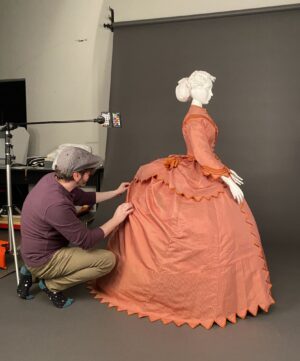
Michael Hall adjusts the Madame Merlot-Larchevêque dress during photography.
Upon first assessment, the dress has many alterations that seem innocuous enough. However, after further inspection and a test fit, the skirt silhouette didn’t fully match the ascribed time period. With my interest piqued, I set to research the subtleties of silhouettes from the late 1800s. My research suggested the current skirt silhouette is dated to mid-1870 and not c. 1864. Mind blown, I returned to the dress itself and studied the aforementioned alterations to better understand why a dress dated c. 1864 appeared to be styled to a later silhouette.
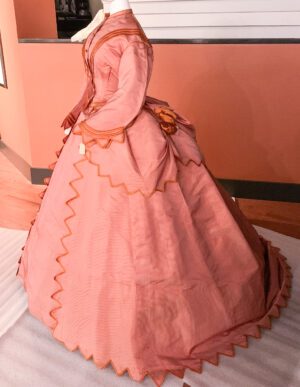
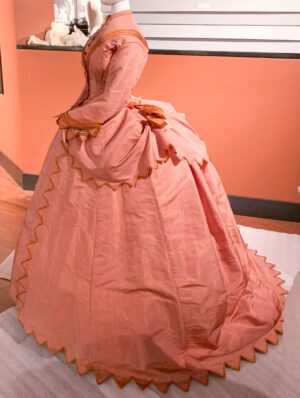
Two dressed versions of the same skirt, one c. 1864 (left), the other c. 1870s (right).
In 1864, women’s fashion saw dresses that were full and round with a nipped waist, sloped shoulders with wide-cut sleeves, and high-set bust. Many of the dress’s original seam lines, cut, and shape all appeared to be from that date, but the alterations told a different story. In the 1870s, prevailing trends took the rounded skirt and swooped it toward the back to create a bustle, which at that time was quite voluminous. Jackets would still be nipped in at the waist, but the sleeves and shoulders would become more tailored.
I noticed the front panel of the skirt was crudely cut and quickly reattached by sewing machine without any attention to seam finishing or correct fit. It was reworked at the waist with an off-centered front panel, pleating that was unevenly replaced, and a hemline that was oblong and draped in a way that contradicted the c. 1864 date.
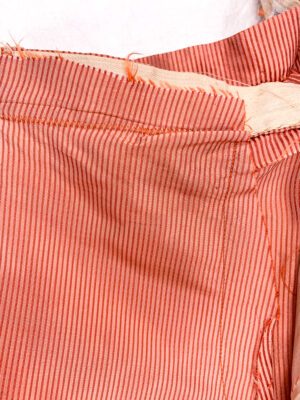
The front of the altered skirt at the waist.
The jacket is further nipped at the waist with additional pieces added to the hem for a grander flare. Additionally, the front of the jacket has loose and missing elements along with some signs of alterations that appear to suggest it was taken in.
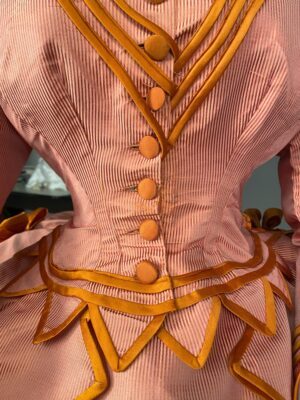
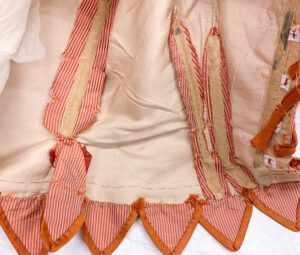
Left: The exterior of the altered jacket with missing parts. Right: The interior with an additional piece inserted at waist.
One may ask, why would someone alter an already gorgeous dress? Simple—to keep up with the fashions of the day. It was not uncommon for people to alter, make repairs, or give older dresses to the younger generation who would modify the older styles into something more modern.
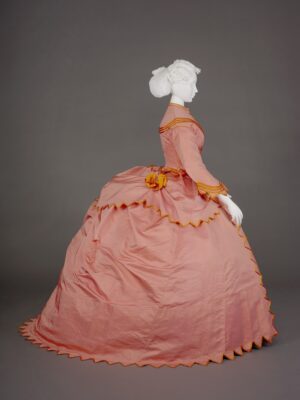
When the dress was photographed, it was styled as it would have been in the 1870s. CHM, ICHi-179975
So, how would I mount a dress that doesn’t have a clear silhouette and have it still be accurate, stable, and supported? I start with the assessment, move onto research, and then build the mount to correspond to the most current state even if it appears counter to what has been originally presented. Next time you see a dress on display that looks a little off, perhaps consider that it wasn’t originally made that way, but instead, was altered to be more “à la mode.”



